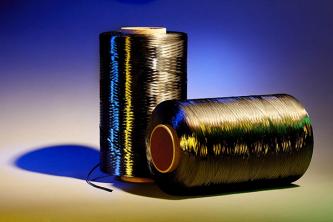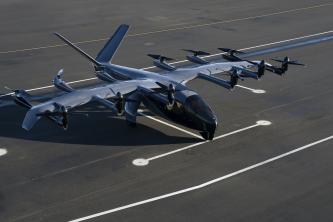The Dawn Of Urban Air Mobility Comes At Midnight

Hexcel is helping Archer become the first company to deliver a safe, reliable eVTOL platform to market.
By Matthew Bates, Director, Marketing & Communications, Hexcel
Meet Maker
During a day-long open house event in mid-November, Archer Aviation, a leader in electric vertical takeoff and landing (eVTOL) aircraft, hosted a large gathering of industry analysts, reporters, customers, and suppliers – including executives from Hexcel – at its campus in Palo Alto, California.
The reason? The much-hyped rollout of the company’s new pilot-plus-four-passenger eVTOL production aircraft, Midnight, which Archer is aiming to have certified by the FAA as possibly the country’s first revenue-generating urban air mobility vehicle.
Archer’s guests received an up-close introduction to the new Midnight aircraft later that day, but first, they boarded several charter buses for a ride down U.S. Highway 101 to Archer’s flight test facility in California’s Central Valley, where its prototype eVTOL aircraft, Maker, was standing-by for a flight test and special VIP viewing.
While guests mingled and awaited the aircraft and chase helicopter to spool up their rotors, Archer Founder and CEO, Adam Goldstein, along with several members of the leadership team, stood on a platform that had been staged on the flightline and gave an overview of the company’s journey that led up to that day.
“From day one Archer’s strategy has always been about finding the most efficient path to commercializing eVTOL aircraft,” said Goldstein. “We believe our strategy and team’s ability to execute on it has allowed us to establish our leadership position in the market, and is why we are confident we will be the first company to certify an eVTOL aircraft in the U.S. with the FAA.”
Archer’s demonstrator aircraft, Maker, is a two-seat prototype vehicle that has generated invaluable data throughout its nearly year-long flight testing program, which Archer has subsequently leveraged in the development of and certification process for Midnight. Maker has 12 propellers attached to six booms on a fixed wing. All 12 propellers provide vertical lift during take-off and landing, like a helicopter. The forward six propellers tilt forward and provide propulsion during forward flight, with the wing providing aerodynamic lift like an airplane.
During the morning flight test demonstration, Maker performed a series of maneuvers that were video recorded via an HD camera turret deployed beneath the chase helicopter and broadcast live to a large screen in the VIP viewing area.
During the test flight, Maker flew by the crowd at nearly 70 knots and at an altitude of approximately 500 feet. This flight demonstrated Maker’s ability to takeoff and land vertically, fly forward at increasingly faster speeds, and operate with a low-noise profile relative to the onlookers on the ground.
Archer’s Chief Operations Officer, Tom Muniz, joined in the applause and the oohs and aahs of the crowd.
“I’ve seen this a hundred times,” he said. “It never gets old.”
The Lightweight Advantage

Earlier this year, Archer and Hexcel announced plans to advance production capabilities for eVTOL aircraft through the supply of high-performance carbon fiber material. Under the proposed relationship, Hexcel will provide Archer with high-performance carbon fiber and resin systems, also known as prepreg, needed to fabricate composite parts for Archer’s production aircraft.
Bob Yancey, Business Development Director at Hexcel, explained that Hexcel’s relationship with Archer began in 2020 when Archer approached Hexcel about providing carbon fiber composites for the vehicle structure.
“Hexcel is the largest composite material supplier in aviation, both for commercial and defense applications,” he said. “The reason carbon fiber is used in aerospace today and the usage continues to grow is because carbon fiber is lightweight and provides you the strength and stiffness that you need for an air vehicle.”
John Moore, Vice President – Product Management, Aerospace (Americas) for Hexcel, explained that both companies have a commitment to “green aviation,” and this partnership is at the center of both companies’ sustainability goals.
“Hexcel has a very strong background in sustainability,” he said. “The number one value proposition of our materials is lightweighting. Not only are we looking for quiet, low emission, low footprint technologies, but we're also looking to scale these things in a way such that Archer can be successful in their business model.”
In addition to providing sustainable technologies, Moore pointed out other benefits Hexcel provides to Archer and the broader aviation industry.
“Hexcel is a vertically integrated company. We're the only composite manufacturer globally that builds everything from raw material inputs to our carbon fiber lines, all the way to finished parts that bolt on to the aircraft,” he said. “Hexcel brings many decades of experience delivering large scale investments online for certification efforts supporting our customers as they work with the FAA and understanding what that means to help Archer as they go through that process.”
Designing Midnight for FAA Certification
Using existing technology from current certificated aircraft is core to Archer’s approach to developing the two Maker prototypes, and for the subsequent Midnight production aircraft. The company says it focused on in-house development only for technologies it could not obtain from other aerospace suppliers.
Archer says it now has “more than 64 percent of [the] suppliers for Midnight’s bill-of-materials selected,” and they are making progress to onboard the remaining suppliers and achieve Type Certification through the FAA in late 2024 – a significant milestone that will prime the launch of its commercial business operations in 2025.
Among the 18 unique certification requirements outlined during the Open House and Midnight Unveil presentation, Archer COO Tom Muniz emphasized that the company’s commercialization-driven certification strategy depends upon design efficiency and simplicity and the need to collaborate and partner with world-class suppliers for the sourcing of existing components with certification heritage.
“We intentionally chose to partner and leverage the great capabilities that exist in the aerospace supply base today,” he said. “That speeds our path to market.”
The primary example cited in the presentation was the process of certifying structural materials, which he referred to as “low risk” due to the tried-and-true standards the industry applies to developing carbon fiber composites for use in aircraft.
“All the materials that go into our aircraft, like the composite materials we use and all the aircraft structure which come from Hexcel, really enable us to meet our performance goals and our goal of bringing a sustainable product to market,” said Muniz. “Hexcel is one of our cornerstone suppliers we partnered with very early in the program because it was clear that they were the right partner to help us bring these products to life.”
“We saw the right level of talent, expertise, capacities and capabilities at Hexcel,” added Vannina Legendre, Vice President, Supply Chain, Archer. “Hexcel fostered a very transparent and collaborative environment for discussion, which is something we were looking for.”
“I think Archer has the right combination of materials technology,” said Moore. “The team that we're working with have experience in the traditional aerospace space, so we have confidence in their pathway to certification and we stand poised to support them as they grow.”
Pioneering Urban Air Mobility

The Midnight pilot-plus-four-passenger aircraft is an evolution of the company’s prototype Maker. Archer is optimizing Midnight, its full-scale production aircraft, to perform back-to-back short distance flights of about 20 miles with approximately 10-minute charging cycles in-between.
The high level of redundancy in Midnight’s design and its simple, electric propulsion system will help make it safer than helicopters, officials say. Midnight has no single critical points of failure, meaning that should any single component fail, the aircraft can still safely complete its flight. In addition, the electric motors used in Midnight have significantly less moving parts than those found in a gas turbine or piston engine, allowing it to operate with less maintenance and lower overall risk. At its cruising altitude of approximately 2,000 feet, Midnight’s design ensures that noise that reaches the ground measures around 45 A-weighted decibels (dBA), nearly silent to residents below. Since Midnight is spinning 12 small propellers rather than one large rotor, it can also spin them at significantly lower tip speeds, resulting in much lower noise levels.
With the growth of companies like Archer, commercial airlines are investing additional capital into this emerging market. One such example is United, which placed a conditional $1 billion order for Archer’s eVTOL aircraft in 2021, with the option to purchase an additional $500 million worth of aircraft in the future. Earlier this year, Archer received a $10 million pre-delivery payment from United for 100 aircraft and announced plans for the first commercial electric air taxi route in the U.S. from downtown Manhattan to Newark Liberty International Airport – an announcement made jointly with United.
United officials confirmed the Downtown Manhattan Heliport, located just above Battery Park on Pier 6, will be the first planned takeoff and landing site as part of Archer’s broader plan to launch an Urban Air Mobility (UAM) network across the New York Metropolitan Area.
“Once operational, electric air taxis will fundamentally change how United customers experience comfort, convenience, and efficiency during their commutes to the airport,” said Michael Leskinen, President of United Airlines Ventures. “Archer’s New York to Newark route marks another important benchmark towards providing a carbon-neutral and safe commute that drastically reduces the travel time and produces a fraction of the sound emitted by helicopters.”
Good Things Happen at Midnight
At the conclusion of the company’s open house presentation, evening had finally arrived, and 175 invited guests took a short walk across the street to the Palo Alto airport for the long-awaited unveiling of the Midnight aircraft.
One by one, they made their way into the aptly darkened hangar, where Archer’s CEO stood in front of the silhouetted aircraft. Shoulder to shoulder, guests squeezed tightly together and jockeyed for a good sight line, pulling out their cell phone cameras to record it all.
“There is a paradigm shift happening in transportation. The future of movement – it’s being reinvented. This is more than just an electric aircraft. We’re building a completely new, sustainable transportation ecosystem. We’re inventing a totally new way to travel. We designed this aircraft around the routes that need this service, and we did it with technology that can be certified. It’s been engineered to scale into a business that opens a trillion-dollar market,” he said.
“This is the future. This is Midnight.”




